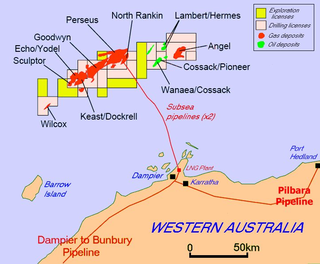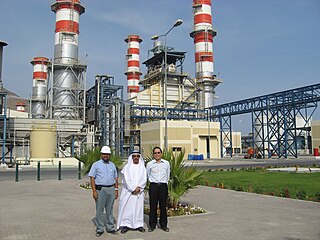Related Research Articles

The United Arab Emirates is situated in the Middle East and southwest Asia, bordering the Gulf of Oman and the Persian Gulf, between Oman and Saudi Arabia; it is at a strategic location along the northern approaches to the Strait of Hormuz, a vital transit point for world crude oil. The UAE lies between 22°50′ and 26° north latitude and between 51° and 56°25′ east longitude. It shares a 19 km (12 mi) border with Qatar on the northwest, a 530 km (330 mi) border with Saudi Arabia on the west, south, and southeast, and a 450 km (280 mi) border with Oman on the southeast and northeast.

Ahmed Ali Al Sayegh is an UAE politician who is Minister of State in the United Arab Emirates since September 2018. He is Chairman of Abu Dhabi Global Market (ADGM), the International Financial Centre in the UAE's capital city.

Gas to liquids (GTL) is a refinery process to convert natural gas or other gaseous hydrocarbons into longer-chain hydrocarbons, such as gasoline or diesel fuel. Methane-rich gases are converted into liquid synthetic fuels. Two general strategies exist: (i) direct partial combustion of methane to methanol and (ii) Fischer–Tropsch-like processes that convert carbon monoxide and hydrogen into hydrocarbons. Strategy ii is followed by diverse methods to convert the hydrogen-carbon monoxide mixtures to liquids. Direct partial combustion has been demonstrated in nature but not replicated commercially. Technologies reliant on partial combustion have been commercialized mainly in regions where natural gas is inexpensive.

The Abu Dhabi National Oil Company or ADNOC is the State-owned oil company of the United Arab Emirates (UAE). It is the world's 12th largest oil company by production. As of 2021, the company has an oil production capacity exceeding 4 million b/d with plans to increase to 5 million bpd by 2030. It is the United Arab Emirate's largest oil company.
The South Pars/North Dome field is a natural-gas condensate field located in the Persian Gulf. It is by far the world's largest natural gas field, with ownership of the field shared between Iran and Qatar. According to the International Energy Agency (IEA), the field holds an estimated 1,800 trillion cubic feet of in-situ natural gas and some 50 billion barrels of natural gas condensates. On the list of natural gas fields it has almost as much recoverable reserves as all the other fields combined. It has significant geostrategic influence.

Qatargas is the world's largest liquefied natural gas (LNG) company. It produces and supplies the globe with 77 million metric tonnes of LNG annually from across its seven ventures—Qatargas 1, Qatargas 2, Qatargas 3, Qatargas 4, RL1, RL2 and RL3. It is headquartered in Doha, Qatar, and maintains its upstream assets in Ras Laffan, Qatar. Natural gas is supplied to Qatargas's LNG trains from Qatar's North Field, by far the world's largest non-associated gas field. It reached a record LNG production of 77 million tonnes per year in December 2010.

QatarEnergy, formerly Qatar Petroleum (QP), is a state owned petroleum company of Qatar. The company operates all oil and gas activities in Qatar, including exploration, production, refining, transport, and storage. The President & CEO is Saad Sherida al-Kaabi, Minister of State for Energy Affairs. The company's operations are directly linked with state planning agencies, regulatory authorities, and policy making bodies. Together, revenues from oil and natural gas amount to 60% of the country's GDP. As of 2018 it was the third largest oil company in the world by oil and gas reserves. In 2020, the company had total revenues of US$21bn, a net income of US$7.9bn, and total assets of US$116bn. In 2021, QatarEnergy was the fifth largest gas company in the world.
RasGas Company Limited was a liquefied natural gas (LNG) producing company in Qatar. It was the second-biggest LNG producer in Qatar after Qatargas. RasGas operated seven LNG trains located in Ras Laffan Industrial City. It was merged with Qatargas on 1 January 2018.

Dolphin Energy is a gas company of Abu Dhabi, United Arab Emirates. It was established in March 1999 by the Government of Abu Dhabi. As of today, Dolphin Energy is owned by Mubadala Development Company, on behalf of the Government of Abu Dhabi,, Total S.A. (24.5%) and Occidental Petroleum (24.5%). It has also a subsidiary based in Doha, Qatar.
Saipem S.p.A. is an Italian multinational oilfield services company and one of the largest in the world. Until 2016 it was a subsidiary of Italian oil and gas supermajor Eni, which retains approximately 30% of Saipem's shares.
The Pearl GTL is a gas to liquids (GTL) plant based in Ras Laffan, Qatar. It converts natural gas into liquid petroleum products. It is the largest GTL plant in the world. The first commercial shipment from the Pearl GTL was made on 13 June 2011.

The North West Shelf Venture, situated in the north-west of Western Australia, is Australia's largest resource development project. It involves the extraction of petroleum at offshore production platforms, onshore processing and export of liquefied natural gas, and production of natural gas for industrial, commercial and domestic use within the state.

Fujairah F1 Independent Water and Power Plant or Fujairah F1 IWPP is an independent water and power plant (IWPP) at Qidfa', Fujairah in the United Arab Emirates. It is located next to the Fujairah F2 IWPP. It is 5 kilometres (3.1 mi) south of Khor Fakkan and 20 kilometres (12 mi) north of the city of Fujairah. When constructed, the Fujairah plant was the first hybrid plant in the Middle East, and the largest desalination hybrid plant in the world.

The Adriatic LNG terminal is a liquid natural gas offshore terminal, formally known as Terminale GNL Adriatico Srl. Located in the northern Adriatic 9 miles (14 km) offshore of Porto Levante, Porto Viro, near Rovigo, Italy, it is the world's first offshore gravity-based structure LNG regasification terminal. The terminal is operated by ExxonMobil (70%), Qatar Terminal Ltd., a subsidiary of QatarEnergy (23%), and Snam (7%).

The natural gas in Qatar covers a large portion of the world supply of natural gas. According to the Oil & Gas Journal, as of January 1, 2011, reserves of natural gas in Qatar were measured at approximately 896 trillion cubic feet ; this measurement means that the state contains 14% of all known natural-gas reserves, as the world's third-largest reserves, behind Russia and Iran. The majority of Qatar's natural gas is located in the massive offshore North Field, which spans an area roughly equivalent to Qatar itself. A part of the world's largest non-associated, natural-gas field, the North Field, is a geological extension of Iran's South Pars / North Dome Gas-Condensate field, which holds an additional 450 trillion cubic feet of recoverable natural-gas reserves.

Crescent Petroleum is the first and largest private upstream oil and gas company in the Middle East. Founded in 1971, Crescent Petroleum is headquartered in the Emirate of Sharjah, United Arab Emirates (UAE), with current operations in both the UAE and the Kurdistan Region of Iraq (KRI).

Ras Laffan Industrial City is an industrial hub located 80 kilometres (50 mi) north of Doha, Qatar. It is administrated by QatarEnergy.

Habshan–Fujairah oil pipeline, also known as "Abu Dhabi Crude Oil Pipeline (ADCOP)", is an oil pipeline in the United Arab Emirates. It starts from the Habshan onshore field in Abu Dhabi and runs to Fujairah on the Gulf of Oman.

Qatar Gas Transport Company Limited, commonly known as Nakilat is a Qatari shipping and maritime company. Its LNG shipping fleet is the largest in the world, comprising 69 vessels. The company also jointly owns one Floating Storage Regasification Unit (FSRU) and 4 very large LPG carriers (VLGCs). Through its in-house shipmanagement, Nakilat manages and operates the four very large LPG carriers and 14 LNG carriers.
Ras Girtas Power Company is a power generation and water desalination plant located in Ras Laffan Industrial City, Qatar. It has installed capacity of 2,730 MW, which include eight gas turbines and four steam turbines by Mitsubishi Heavy Industries. The first stone of the plant was officially laid on 4 May 2009. The plant was commissioned on 31 May 2011 in the presence of the emir, Sheikh Hamad bin Khalifa Al-Thani, and it cost US3.9 billion. Once fully operational, the plant will produce 286,000 cubic metres per day (10,100,000 cu ft/d) of desalinated water. It uses ten multi-effect distillation/thermal vapour compression units built by Sidem.
References
- 1 2 "MEED - Dolphin Pipeline: Top stories and fast facts". 2008-06-16. Retrieved 2008-06-25.
- 1 2 3 4 5 6 7 8 "Dolphin Gas Project, Ras Laffan, Qatar". hydrocarbons-technology.com. Retrieved 2007-07-12.
- 1 2 "New Processing Plant at Ras Laffan Under Test" (Press release). Dolphin Energy. 2007-06-25. Archived from the original on 2007-09-27. Retrieved 2007-07-12.
- ↑ "Dolphin Energy produces first gas in Qatar and supplies UAE customers" (Press release). Dolphin Energy. 2007-07-10. Archived from the original on 2007-09-27. Retrieved 2007-07-12.
- ↑ Critchlow, Andy (2006-07-12). "Saudis demand say in Emirates pipeline". International Herald Tribune. Retrieved 2007-07-12.
- ↑ "UAE & Oman sign first GCC gas pipeline accord" (Press release). Dolphin Energy. 2004-03-29. Archived from the original on 2007-06-08. Retrieved 2007-07-12.
- ↑ "Dolphin makes Oman leap". Upstream Online. NHST Media Group. 2008-11-03. Retrieved 2008-11-09.
- 1 2 Klaus, Oliver (2008-05-05). "Dolphin Energy Set To Receive Pipeline Bids". Downstream Today. Dow Jones Newswires. Retrieved 2008-05-10.
- ↑ "Dolphin Energy issues tender documents for Taweelah-Fujairah Gas Pipeline project" (Press release). Dolphin Energy. 2007-11-11. Archived from the original on 2007-12-14. Retrieved 2007-11-24.
- ↑ Hatoum, Majdoline (2008-07-23). "Dolphin Taps Russian Firm for $418M Gas Pipeline Contract". Downstream Today. Dow Jones Newswires. Retrieved 2008-07-26.
- ↑ "Stroytransgaz begins work on Taweelah Fujairah gas pipeline". SteelGuru. 2009-03-13. Retrieved 2009-03-18.
- ↑ "Stroytransgaz celebrates completion of phase2 of Dolphin gas pipeline". WAM/MAB. 2010-05-21. Retrieved 2010-05-29.
- ↑ "Delayed Dolphin pipeline extension completed". Utilities-ME.com. ITP Business Publishing Ltd. 2010-05-06. Retrieved 2010-05-29.